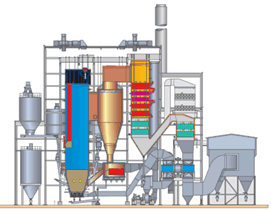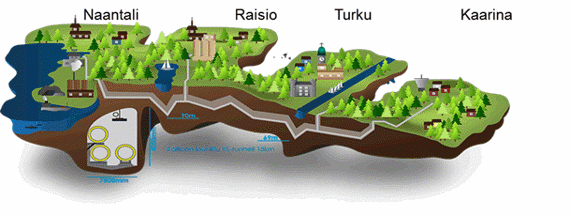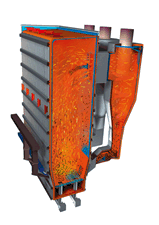Environmentally friendly energy with renewable fuels
Valmet will deliver a boiler plant to the power plant of Turun Seudun Energiantuotanto Oy in Naantali on the Southwestern coast of Finland. Once started up, the boiler will produce district heat and electricity for the area of Turku and process steam for the needs of nearby companies. This large-scale multi-fuel plant is designed to generate power by utilizing solely bio fuels at a very high efficiency ratio. The plant is scheduled to start up in the fall of 2017.
The new power plant unit will open an opportunity to increase the use of renewable fuels. In addition to a Valmet CFB Boiler (CYMIC at the time) that utilizes circulating fluidized bed technology and features steam efficiency of 390 MW, Valmet’s delivery includes flue gas cleaning equipment. The boiler and flue gas cleaning are designed to comply with the IEA emissions directive that will come into force in the European Union in the beginning of 2016.

Figure 1. Valmet CFB Boiler which will be delivered to Turun Seudun Energiantuotanto in Naantali.
Biofuel will be acquired locally
The new multi-fuel power plant of Turun Seudun Energiantuotanto Oy (TSE) will replace an old coal power plant that has been in operation for 50 years. The new plant will use wood, straw, peat, coal, and solid recovered fuel (SRF) in power generation. Once up and running, the plant will produce 900 GWh of electricity and 1,650 GWh of heat in a year. The electrical capacity is 142 MW and the heat capacity 244 MW.
Locally acquired wood chips will form an important part of all biofuel used at the plant. Wood chips will be collected within a 100-150 kilometer radius around the power plant. The plant will utilize approximately 0.7 solid cubic meters annually. Later on, the total amount may increase to 12 million solid cubic meters.
Use of renewable energy creates jobs
“The power plant investment opens an opportunity for energy-efficient combined heat and power production with renewable fuels. Our aim is also to maximize the use of domestic fuels in energy production. We will be more independent from foreign fuel supply, and will be able to affect the employment of the area in a positive way,” says Tapani Bastman, managing director at Turun Seudun Energiantuotanto Oy.
At its best, the construction of the plant will employ approximately 500 people. According to the plans, construction work will start toward the end of the year. Once the plant has started up, acquisition of domestic fuel will offer approximately 200 permanent jobs.

Figure 2. The Naantali power plant produces electricity and heat for the entire Turku area.
Combustion of mere biomass also possible
The boiler can be utilized for combustion of mere biomass without any fossil fuels. This is enabled through Corrostop, which is an additive developed by Valmet for superheater corrosion control. The superheaters, which have the highest temperatures, will be located in the cyclone loop seal, away from the furnace. These superheaters absorb heat only from the material that is returned from the cyclone.
Sulfur contained in the fuel is absorbed by feeding powdered lime into the furnace. Nitrogen dioxide emissions are controlled through injection of ammonia in the cyclone inlets. The boiler will also be prepared for tighter emissions regulations through the possibility to add a NOx catalyst in the tertiary pass. Flue gases will be cleaned in a bag house filter. If waste-derived fuel (SRF) is used, infeed equipment for calcium hydroxide and activated carbon will be installed before the bag house filter.
The heat contained in the flue gas can be efficiently recovered by means of a rotating pre-heater, which enables a low end temperature of flue gas without corrosion problems. The efficiency ratio of the boiler, in other words the proportion of fuel energy gathered in steam, is greater than 92%.
Steam is fed from the boiler to a steam turbine at 164 bar pressure and 555°C temperature. The Naantali power plant will be a so-called reheat plant, in which steam is returned from the turbine to the boiler for firing, and the steam that has been superheated will be fed back to the turbine at 44 bar pressure and heated to a temperature of 555°C. Temperature control in the reheat steam will be handled by passing part of the sand returned form the cyclone past a hot reheater, which is located in the return of the hot cyclone. This solution enables the highest possible electrical efficiency ratio.
Valmet CFB Boiler is a circulating fluidized bed power boiler developed by Valmet
The Valmet CFB Boiler enables the use of diverse solid fuels in energy production. Thanks to advanced technology, emissions are extremely low even when fuels with totally different thermal values are combusted simultaneously.
The temperature capacity of Valmet CFB Boilers varies from 50 MW to 1,200 MW.
The fuel flexibility of CFB boilers is superior. Most of the more than 80 plants delivered by Valmet worldwide are multi-fuel boilers, which combust biomass and fossil fuels, the proportion of which may vary continuously. Multi-fuel combustion is an environmentally friendly method, which enables high availability. A possibility to use several different fuels offers a good opportunity for optimization of operating costs.
Figure 3. The combustion process temperature profile is stable in a Valmet CFB Boiler. This provides optimal conditions for using a diverse fuel portfolio in energy production.
In addition to coal and other solid fossil fuels, the technology of CFB boilers enables utilization of recycled fuels, bio mass, and agro fuel, as well as combinations of these in energy production.
The first large-scale Valmet CFB Boiler used for electricity production started up in the 240 MW power plant of Alholmen in Pietarsaari in 2002. The development of the boiler construction, sand super heaters among others, has continued since the Alholmen delivery. Multi-fuel CFB boilers that were delivered during the 2000s have proven their reliability.
A local energy producer
Turun Seudun Energiantuotanto Oy produces district heat and electricity for the Turku and Naantali city areas, and process steam for the needs of nearby companies. The company is owned by Turku Energia, the municipalities of Raisio, Kaarina, and Naantali, and the company Fortum Power and Heat.
The Naantali power plant was originally Fortum’s condensing power plant, which used coal as fuel. The first unit was built in 1960. In 1972, this plant, formed by three units, was the biggest coal power plant in the Nordic countries. The Naantali plant was changed into a back pressure power plant at the beginning of the 1980s, and distribution of heat produced at the plant to the district heat networks of Turku, Raisio, and Kaarina was started. The distance between the power plant and the center of Turku is approximately 15 kilometers. Fortum sold the power plant to Turun Seudun Energiantuotanto Oy in 2013. Today, the plant is operated by around 100 Fortum employees. The Naantali plant produces heat for approximately 180,000 inhabitants in the city of Turku and the surrounding counties.
At a glance: The new multi-fuel boiler plant for Turun Seudun Energiantuotanto Oy (TSE)
| Deliver | Valmet CFB Boiler that utilizes circulating fluidized bed technology and flue gas cleaning equipment. |
| Start-up | 2017 |
| Capacity | steam efficiency of 390 MW |